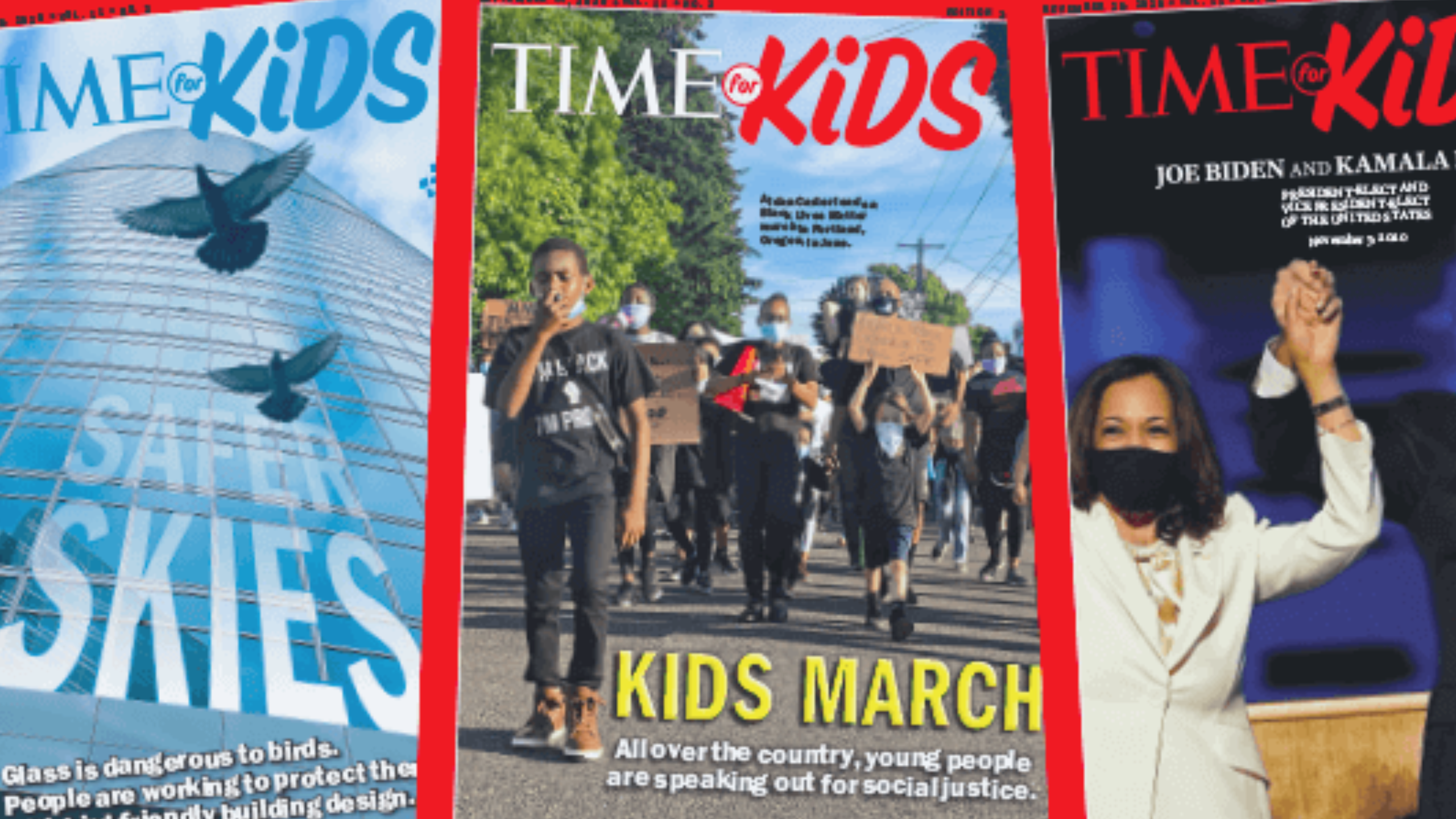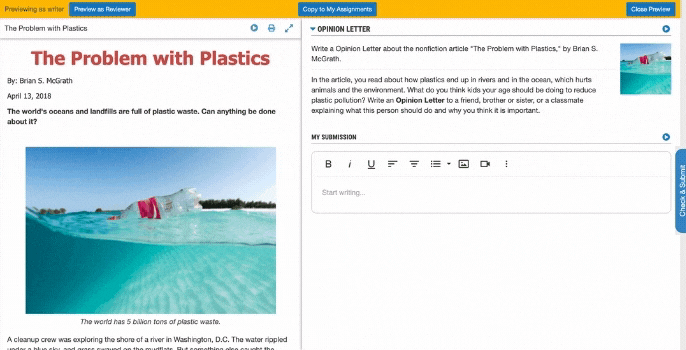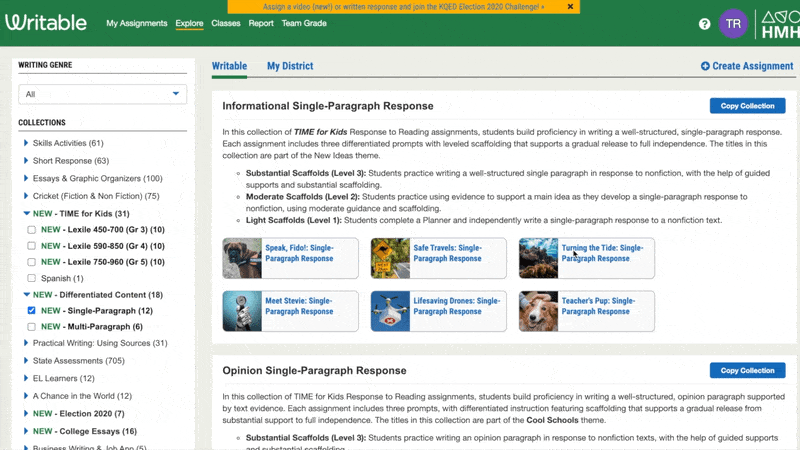We’re excited to announce our three newest collections of assignments for elementary students that include Lexile leveled readings between 450 and 950 from TIME for Kids! Each Response to Reading assignment contains at least one non-fiction TIME for Kids article with an associated prompt, many with the option for English or Spanish readings.
Assignments that include TIME for Kids nonfiction articles are included in three new Writable collections that have associated prompts from across the genres. You’ll find over 40 TIME for Kids articles in Writable, with more coming soon! These collections are:
The Time for Kids Collection: This collection is organized by Lexile level ranging from 450 to 950 (traditionally supporting grades 3-5), with Response to Reading single-paragraph prompts that cover opinion/argument, information, and narrative genres. Assignment styles include journal entries, blog posts, op-eds, video summaries, short stories, informational presentations, and more.
Differentiated Content Collection: Single Paragraph: This collection includes single-paragraph Response to Reading prompts with 6 assignments per genre-organized collection that can be used as curriculum blocks. Each assignment prompt is differentiated to three varying levels of scaffolding and support to meet the needs of all students. The types of support include organizers, sentence starters, hover explanations, and more.
Differentiated Content Collection: Multi-Paragraph: This collection includes multi-paragraph Response to Reading prompts with 6 assignments per genre-organized collection that can be used as curriculum blocks. These assignments are designed for students who are already comfortable with single-paragraph writing or who have completed the assignments in single-paragraph collection. Each assignment prompt is differentiated to three varying levels of scaffolding and support to meet the needs of all students. The types of support include organizers, sentence starters, hover explanations, and more.

Assignments in the TIME for Kids Collection
Every assignment in this collection designed for grades 3-5 contains at least one TIME for Kids reading with an associated single-paragraph Response to Reading prompt. Many assignments have the option for the reading(s) to be in either Spanish or English (for more information on supporting English learners in Writable click here). All readings are nonfiction articles written by the TIME for Kids editorial staff and each reading is leveled by Lexile level ranging from 450 to 950. There are more than 40 TIME for Kids articles in Writable that cover a wide range of topics including science and social studies, current events, and pop culture. Articles are written to engage and appeal to students in their target age group.
Teachers have the option of guiding students to read the articles independently in Writable or to print the readings for offline learning. Students can also use the text-to-speech feature in Writable to have readings (as well as prompts and directions) read aloud to them. Teachers can alternatively choose to read the articles aloud with students during synchronous learning, guiding them to read at an instructional level. Because of the wide range of reading levels for each article, all students can access, and be engaged by, the information in each assignment.
The associated Response to Reading prompts cover Opinion/Argument, Information, and Narrative writing genres. Every assignment in Writable is completely customizable which allows you to treat an assignment like a template and edit the prompt, directions, or rubric. You can also add in video instruction, additional resources, graphic organizers, multiple choice questions, and more. Some of the types of assignments in the TIME for Kids Collection that you’ll find are summary, informational, opinion, and descriptive paragraphs, op eds, persuasive and informative speeches, journal entries, blog posts, personal narratives, informational presentations, letters, and more.

Differentiated Assignments with TIME for Kids Readings
Writable’s curriculum team has developed differentiated assignment collections for elementary students built around developing necessary skills and building proficiency for mastering single and multiple paragraph writing. Each collection is focused on a theme and every assignment within the collections contains at least one TIME for Kids nonfiction reading and associated prompt (note: readings within the assignment are also available in Spanish. For more information on supporting English learners in Writable click here).
The single-paragraph differentiated assignment collection is a great place for students to start if they have not yet mastered the art of paragraph writing, or if you’re unsure of a student’s abilities. The multi-paragraph differentiated assignment collection is designed for students who are comfortable with paragraph writing or who have completed the single-paragraph collection. These collections can be treated as curriculum blocks, supporting and providing scaffolding for students as they build their paragraph writing skills.
These differentiated assignments enable teachers to teach the same content using greater or lesser support to a group of students who are at different ability levels. The assignments make it possible to teach close reading, text analysis, and expository, persuasive, and narrative writing in a variety of settings including whole class, small group, and individual/independent.

How Assignments are Differentiated
The goal when differentiating literacy instruction is to foster improvement leading to proficiency. When we meet students where they are, and provide the appropriate guidance and support, we are then able to move them towards reading and writing proficiency.
Each differentiated assignment in Writable contains three levels of prompts built to support varying needs of scaffolding and support. The assignments contain a combination of leveled readings, graphic organizers, sentence starters, hover texts, and more. These are how we define the levels in Writable:
Substantial Scaffolds (Level 3): This level provides the highest level of scaffolding and support. We recommend all students begin at this level unless their level of need has been previously assessed in Writable.
Moderate Scaffolds (Level 2): This level provides a moderate level of scaffolding and support. A student who is able to score 3 to 4 stars on a Level 3 assignment should move to a Level 2 assignment.
Light Scaffolds (Level 1): This level provides the least amount of scaffolding and support. Students at this level are able to score a 3 or 4 on a Level 2 assignment and are able to write well-structured paragraphs independently.
For more information on how to choose the appropriate level, to best pace assignments, and differentiate instruction using these assignments, please refer to our instructional suggestions in the next section.
Within Writable’s differentiated assignments, students are given support in 4 major areas:
- Analyzing the text: students are given support and motivation in finding the main idea, identifying key details, and identifying any possible subplots while reading the nonfiction texts.
- Understanding and writing about the content: depending on the assignment level, students may have sentence starters that help them begin writing their main idea or topic sentence, hover text that guides students towards identifying a main topic, evidence, or idea, and planners with built-in structure and organization so students can focus on content.
- Organizing and structuring their writing: the assignment levels are built to support students at varying abilities to structure a cohesive paragraph. Depending on the level, assignments feature hover text that provides additional guidance so students can build coherence, sentence starters and model sentences that reinforce sentence transitions and connecting ideas within a paragraph, and planners with pre-built structure and organization.
- Revising and polishing their writing: all students are supported through formatting, sentence starters, and hover text to edit and revise their writing. The formats and model paragraphs provide specific and customized models in word choice, voice and tone, sentence variety, and spelling and punctuation.

How to Differentiate Instruction Using Differentiated Assignments
First, it’s important to answer the question: do you know what level of scaffolding and type of assignment that will best support each student’s learning? If the answer is yes, simply choose the appropriate level for each student based on their needs. If you’re unsure how much scaffolding and support a student requires, then it’s best to start each student at Level 3 (substantial scaffolds) single paragraph assignment. We expect students on average to complete an assignment in a week.
A key aspect to differentiating instruction is assessing students in order to continually define and refine their learning needs. Writable makes it easy to assess students because you can use multiple types of feedback and comprehensive data to see how students are succeeding on a single assignment or how their writing is progressing over time.
Once students complete their first Level 3 assignment you can assess their work using peer, self, teacher, or AI-powered review. If the student receives an average of 3 to 4 stars, it would be appropriate to move them up a level of difficulty to a Level 2 assignment next (moderate scaffolding). If a student earns an average of 1 to 2 stars on their first assignment, it’s appropriate to continue to use a Level 3 assignment until their work improves. For a student requiring a Level 3 assignment, we expect a student to require substantial scaffolds for approximately 4 assignments before they are ready to move into a moderately scaffolded assignment.
Students will be ready to move into Level 1 only once they achieve an average of 3 to 4 stars on a Level 2 assignment. By using differentiated assignments, eventually all students will likely only need a light level of scaffolding, graduating to writing independence. Some students may require all six assignments in the single-paragraph differentiated collection to achieve this goal, or they may need to continue to the next differentiated collection of assignments as a Level 2 or 3, while others might achieve writing independence once completing just a few assignments.
There will of course be variations in progression based on student entry level, instructional time, time spent writing, etc. We believe that if a teacher uses the materials with fidelity, and spends some individual and group time on text analysis, close reading, and writing support, all students will attain writing independence.

Customizing Learning & Differentiating Any Assignment with Writable
Now you can use Writable’s tools to differentiate any assignment, creating your own prompt levels of difficulty, in addition to being able to completely customize every assignment in Writable. This feature can be especially helpful if you’re looking to level an original assignment that you’ve created or differentiate instruction for older students.

We understand that differentiating your own assignments can be time consuming. Writable is unique in that it allows you to customize learning around both your goals and the time you have available to spend preparing instruction and curriculum. You can take a lighter touch by customizing or creating assignments tailored to your classes, add in more support for individual students with the use of scaffolding via graphic organizers, sentence stems, and additional resources, or take a heavier touch by fully differentiating prompts and/or readings in an assignment based on individual student needs.
While all students benefit from customized learning, students with accommodations, such as students with IEP’s or 504’s, and English language learners, are often required to have differentiated levels of support. With Writable, this is possible, even when your students are learning from home.


Are you new to Writable or curious to learn more? Create a free teacher account, check out our pricing, schedule a personalized demo, or Join the Writable Educators Facebook Community.





